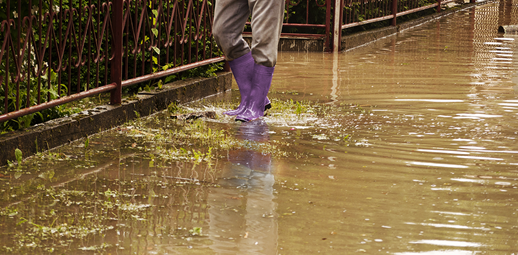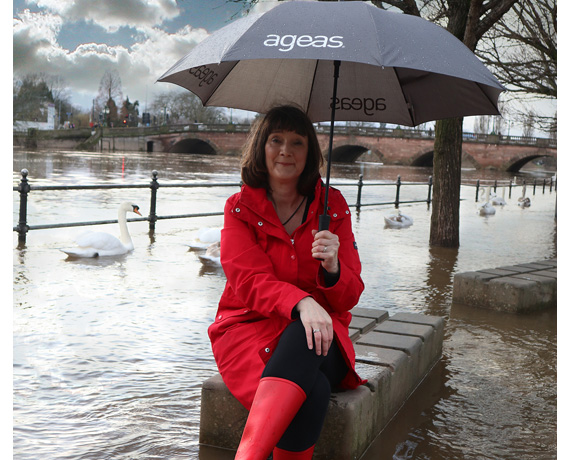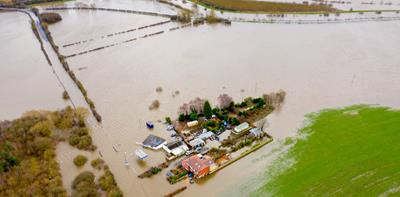
Picture the scene: it’s mid-summer and it has been hot and dry for days, with hardly a cloud in the sky. Your garden is looking parched and you might even be wishing for a bit of rain.
But after long stretches of summer heat often come thunderstorms. And a sudden change in the weather can have consequences many people aren’t prepared for – flash floods, something we’ve started to see more frequently.
Floods…. in the summer?
Prolonged hot and dry conditions can bake the ground hard, sometimes so much the soil cracks. And if there is sudden, significant rainfall, the ground is unable to soak up the water and instead, the deluge can overcome drainage or sewerage systems.
This has happened many times before - in 2012, for example, many areas of the country were badly hit by flash flooding, after storms that followed a long period of dry conditions. Worse still was the summer of 2007, when over 55,000 properties were flooded across England and Wales.
Everyone should be prepared
After summer thunderstorms, it’s not just homes in areas of well-known high flood risk that could be affected
Mary Dhonau OBE, chief executive of the Know Your Flood Risk campaign and a champion for community-based flood resilience, says: “Never say never. Surface water flooding poses a big threat because we’ve all paved over our drives. When water hits the ground, it hits the ground running. And because it’s so tinder dry, it will pose a much bigger threat to flood.”
Though it pays for everyone to be prepared, it can help to see if your home is at particular risk from floods. Use the Gov.uk website if you live in England, or check flooding in Wales, Scotland or Northern Ireland.
Steps you can take to protect your home
There are things you can do to prepare yourself and your home to protect against floods, even at the last minute.
Mary, who has herself been the victim of flooding, recommends going to your local DIY store and buying "air brick covers" to help stop the water from entering your home. These aren’t expensive and are easy to fit.
The classic flood protection measure is to install sandbags. But, Mary says: “They’re useless and an environmental hazard”. Instead, she recommends buying flood sacks to do the same job. These are available online and are each capable of absorbing 21 litres of water, she says. These should be placed on both sides of your door.
And don’t forget to move your car to higher ground. “The last thing you want is a flooded car and a flooded house,” says Mary, “then you’ll have two insurance claims and you’re in the river without a paddle.”
Resources for home owners

Packed with tips, videos and articles to help you protect your home before, during or after a flood. We've partnered with Flood Mary, the property Flood Resilience champion to create a short video series full of useful pointers.
Other simple tips to prepare for potential flooding, and to deal with the consequences, include:
- Sign up for flood alerts by phone, email or text message. These are available in England, Wales and Scotland, and come directly from the Environment Agency. You can use flood maps to check flooding risk in Northern Ireland.
- Take detailed photos of your property and contents before an expected flood to help with any potential claim. If your home is flooded, register your claim with your insurance company as soon as you can.
- Move your valuables to a higher level.
- Use thick plastic sheeting to cover up any air vents, as these are a common entry route for flood water.
- Try not to walk in the water as it could be contaminated with sewage.
- If you leave your home during a flood, you’ll need to turn off your mains water, gas and electricity if it’s safe to do so.
- Avoid driving on flooded roads. Don’t stop the car in standing water, and drive through the highest section of the road slowly.
Build Back Better
You may also be able to benefit from the Build Back Better scheme, launched by an organisation called Flood Re. The scheme is designed to reduce the cost and impact of future floods by including property resilience measures as part of flood repairs.
Ageas was one of the first insurers in the UK to offer Build Back Better to customers. If a customer’s home is flooded, and they meet the criteria for the scheme, then we’ll offer them up to £5,000 towards the installation of flood resilience measures.
Read more about the Build Back Better scheme.
For more information about how to protect your home and belongings, go to Solved.
Original article published in July 2018; last updated in July 2024

